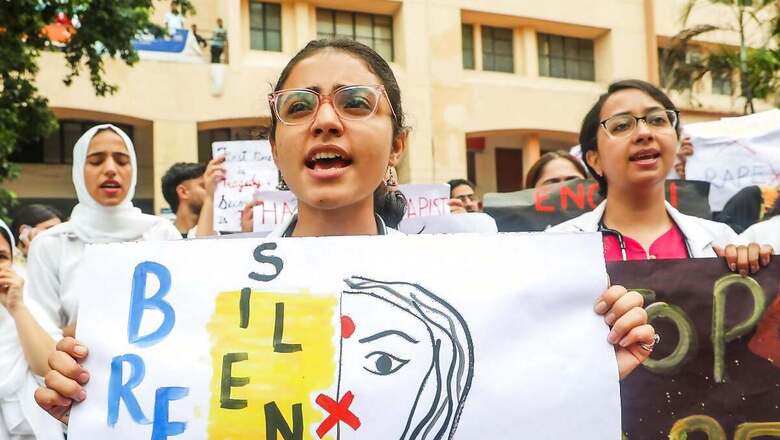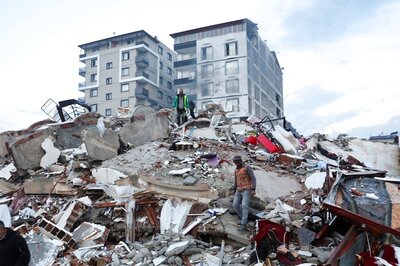
views
What women in India are trying to do is merely survive – many unsuccessfully so. That should be a reminder of how we have failed them as a nation and society. What is the solution?
Twelve years after the brutal gangrape of Nirbhaya in the national capital shook our collective conscience, no material change has been seen on ground. In fact, matters have only gotten worse. The stricter punishments, including the death penalty for rapists, are doing little to prevent heinous crimes against women. As per the annual National Crime Records Bureau (NCRB) report, between 2017 and 2022, a total of 1.89 lakh rape cases were reported in India, involving 1.91 lakh victims. The problem is, this figure does not present the full picture – not even remotely so.
Rapes and sexual violence against women are, even today, grossly underreported in India. The reality, therefore, is far worse than one could imagine.
The time to talk about solutions to this societal menace is now. Passing tougher laws and all other related measures is doing little to alleviate the woes of Indian women. So, what is the way forward? Unfortunately, there is no tried-and-tested formula that can be implemented nationally. What is known for a fact, though, is that tackling this menace requires a national strategy and a whole-of-society approach to it. The conversation around making India safer and liveable for women needs to happen immediately, and this is not a conversation to be had in silos.
Rope in the Panchayats, Make Women’s Safety a Non-Negotiable
For starters, the government needs to engage with a cross-section of civil society and organisations committed to changing the reality for women on the ground. India needs a pool of organisations and individuals who are driven by the sole agenda of helping women lead safer lives. Their work must begin at the panchayat level. The state and Central governments must work in tandem to ensure that panchayats are sensitised on the issue of women’s safety and are made to work constantly to ensure that violent crimes against women, beginning with rape and sexual assault, are nipped in the bud.
This requires a mindset change at the societal level, for which the participation of panchayats is crucial. Men must be made to fear the consequences of such crimes. The fear of the law has to be implanted in every man’s psyche. Panchayats that refuse to toe the line must be made to fall in line by the government. Village councils seen as lacking, disinterested or indifferent to women’s safety must be made to feel the financial pinch if push comes to shove. Penal action in such cases should not be off the table either.
This requires a cross-party consensus. All political parties – national and regional alike – must come to the same table and commit to working together on this agenda. They must all commit to a hardline stance on women’s safety, essentially meaning that irrespective of who wins state or general elections, the pressure on grassroots governance bodies has to be constantly maintained. Again, it is the Central government that must take the initiative of building this consensus and ensuring that it trickles down to the grassroots. That can only be achieved by the Centre working together with the states. The safety of women has to be a non-negotiable and a policy of “zero-tolerance” has to be institutionalised. The same needs to be impressed upon India’s khaps and panchayats.
Make Schools, Colleges and Workspaces Centres of “Re-education”
The task at hand is a mammoth one, and there are no immediate fixes in sight. However, if the future of Indian women is to be secured, children and youth need to be re-educated at schools, colleges and workspaces. Sex education is no longer an option, it has become an absolute necessity. A policy effort must be undertaken by the Central government to ensure that all schools across the country have designated teachers or counsellors whose sole mandate is to tell students what constitutes wrong, unhealthy and criminal sexual behaviour.
Schools and colleges must also take the lead in challenging pervasive ideas of patriarchy and misogyny which many Indian children find being perpetuated in their homes on a daily basis. Educational institutes will have to work with social organisations and women’s rights groups, and the government should facilitate the same. As I mentioned earlier, this has to compulsorily be a whole-of-government-and-society effort.
Focus also needs to be laid on the informal work sector, where Prevention of Sexual Harassment (POSH) guidelines are not as publicised as they are in formal corporate workspaces. Schools, colleges and workplaces must become the trident of reforming Indian society, where boys and men are constantly reminded of a woman’s right to dignity and safety. These must also become centres where patriarchal notions are challenged every step of the way.
Need of the Hour: Sustained, Spirited and Effective Communication Campaigns
India is no stranger to effective mass communication campaigns initiated to bring about behavioural changes in society. Whether it be the slogan “Hum Do Humare Do”, popularised in the 1950s to promote family planning across the country, or more recently to Atal Bihari Vajpayee’s very famous “School Chalein Hum” slogan under the Sarva Shiksha Abhiyan, India has what it takes to convey a message across the country. The question is, why a mass communication campaign focused on women’s rights, safety and security has not been undertaken at a national scale yet?
Such a campaign is the need of the hour. It is high time that the media of the country and all modes of information transmission – print, broadcast and digital – are flooded with one simple yet effective message – that violence against women is a crime that shall not go unpunished. Again, it is the government that must take the lead on this front and ensure that a sophisticated campaign with a timeline of several years is set into motion. The same campaign must be taken to the panchayats, schools, colleges and workplaces and be incorporated into their efforts to sensitise men.
The government should also explore initiating more targeted behavioural change campaigns (BCCs) to raise awareness among women about the rights they have and the laws put in place to safeguard them. For India to effectively combat its rape culture, it is of utmost importance that men not only know about the consequences of violating a women’s dignity, but also see justice being meted out in a swift manner. This is where India’s judicial system must step up. The courts must realise that in the absence of swift justice, the fear which potential rapists should have of the law is severely diluted. It also provides criminals with ample opportunity to coerce victims and their families into withdrawing complaints, or worse, physically harming them.
Ultimately, Indian society must undergo a deeper reform. We need to critically examine the content we consume; the language men use when discussing women, the persistent stereotypes, and the casual misogyny that often serves as the breeding ground for violent crimes and rape. This change must start on an individual level, for any societal transformation is hollow if those advocating it are themselves shackled by outdated and harmful beliefs about women.
Views expressed in the above piece are personal and solely that of the author. They do not necessarily reflect News18’s views.




















Comments
0 comment